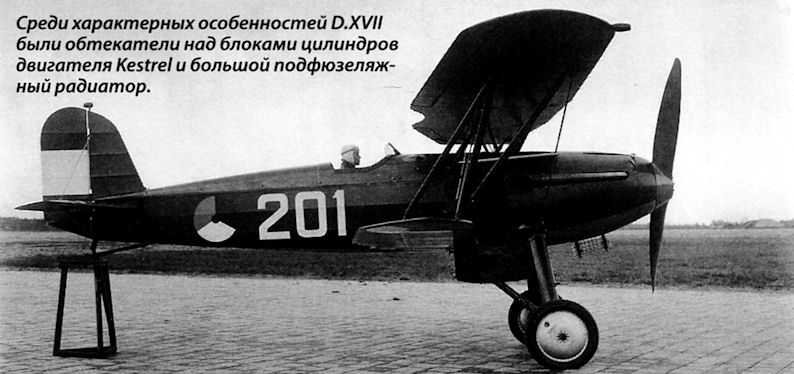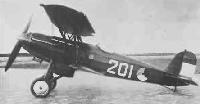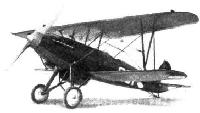
Fokker D.XVII
Одноместный истребитель D.XVII был дальнейшим развитием самолета D.XVI, но уже с рядным двигателем Curtiss V-1570 Conqueror и рядом конструктивных и аэродинамических нововведений. Он предназначался для армейского авиакорпуса Голландской Ост-Индии. Но когда в 1932 году был построен прототип, у заказчика не оказалось денежных средств на него, и машина была испытана армейским авиакорпусом Нидерландов. После этого был выдан заказ на 11 серийных машин, к которым позднее присоединился прототип, отремонтированный после серьезной аварии в Ост-Индии. Несмотря на небольшое число построенных машин, существовало три их варианта: с двигателем Hispano-Suiza 12Xbrs в 690 л. с. (515 кВт), с 790-сильным (589 кВт) двигателем Lorraine-Dietrich 12Hfrs Petrel и, наиболее распространенный, вариант с двигателем Rolls-Royce Kestrel IIS. Несмотря на эту чехарду с моторами, D.XVII пользовался любовью у пилотов.
Если бы не успех моноплана D.XXI, сменившего D.XVII в боевых частях, последний мог бы получить закрытую кабину, но от этой идеи отказались. Когда 10 мая 1940 года Германия вторглась в Нидерланды, в армейской летной школе на острове Тексель находилось шесть D.XVII. Будучи в совершенно отчаянном положении, голландцы бросили их на прикрытие двухместных самолетов C.V и C.X, наносивших удары по колоннам германской бронетехники.
ТАКТИКО-ТЕХНИЧЕСКИЕ ХАРАКТЕРИСТИКИ
Fokker D.XVII
Тип: одноместный истребитель
Силовая установка: один V-образный ПД Rolls-Royce Kestrel IIS мощностью 595 л. с. (444 кВт)
Летные характеристики: максимальная скорость на высоте 4000 м - 350 км/ч; крейсерская скорость на высоте 4000 м - 290 км/ч; потолок 8750 м; дальность полета 850 км
Масса: пустого 1100 кг; максимальная взлетная 1480 кг
Размеры: размах крыла 9,60 м; длина 7,25 м; высота 3,10 м; площадь крыльев 20,00 м2
Вооружение: два 7,9-мм пулемета M.36 в носовой части фюзеляжа
Описание:
- Fokker D.XVII
- Flight, March 1934
A DUTCH FIGHTER
Фотографии
-
Мировая Авиация 135
Среди характерных особенностей D.XVII были обтекатели над блоками цилиндров двигателя Kestrel и большой подфюзеляжный радиатор.
-
Flight 1934-03 / Flight
THE FOKKER D.XVII: This is the "Kestrel"-engined version supplied to the Dutch Army Air Force
-
Flight 1933-09 / Flight Advertisements
FOKKER DXVII'S (ROLLS-ROYCE KESTREL) SUPPLIED TO THE DUTCH AIR FORCE
-
Flight 1934-09 / Flight
SOLIDITY: The great wing depth of the Fokker F.36 inspires confidence. It has searing accommodation for 32 passengers The Fokker single-seater fighter gives a good idea of the size of the F.36.
Другие самолёты на фотографии: Fokker F.XXXVI / F.XXII - Нидерланды - 1934
-
Flight 1933-09 / Flight Advertisements
The Instrument Panel showing a range of Smith's Instruments including :- Revolution Indicator, Air Speed Indicator, Altimeter, "Time-of-Flight" Clock, Gauges, & c., & c., and the turn and bank indicator
-
Flight 1934-03 / Flight
THE FOKKER D.XVII: This drawing shows the machine fitted with a Curtiss "Conqueror" engine. Later versions have the "Kestrel," Hispano-Suiza 12 Xbrs or Lorraine "Petrel."
-
Air Enthusiast 2001-09 / F.Gerdessen - Fokker's 'Paper' Fighters
Fokker D.XVII, dated November 29, 1930.
-
Air Enthusiast 2001-09 / F.Gerdessen - Fokker's 'Paper' Fighters
Three-view: Fokker D.XIX. Centre, right: Ont.112, bottom right, Ont.124.
-
Air Enthusiast 2001-09 / F.Gerdessen - Fokker's 'Paper' Fighters
Fokker D.XVII-B - three-view dated November 7, 1935, lower right dated June 4, 1936.
- Фотографии









